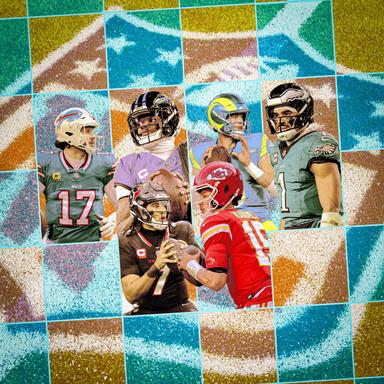The Buffalo Bills and Baltimore Ravens have been destined for Sunday’s divisional round matchup all season long. We don’t need to sell the stakes for this game any further: Quarterbacks Josh Allen and Lamar Jackson are duking it out for (presumably) another opportunity to climb up Mt. Mahomes and plant their flag as the new king of the AFC—and it’s possible that the story lines leaving this game will be bigger than those that follow the Super Bowl. Put simply, Sam Spence’s scores for NFL Films were made for games like this.
You know this game matters. Now let’s dig into the film to identify potential winning edges for both teams. Whether it’s to impress your in-laws with a surface-level understanding of the game, or the college buddy who won’t shut the hell up about the datasets he used to build his fantasy team, here are the most important factors to this season’s biggest game.
Lamar Jackson Is the NFL’s Best Pocket Passer, and Baltimore’s System Is Finally Built to Showcase That
Football fans are familiar with what Jackson can do when he holds onto the ball and makes magic happen, but those highlight-reel plays are actually not what’s behind his leap in production this season. With two MVPs and All-Pro nods under his belt entering the 2024 season, it feels inconceivable to say Jackson is seeing the field better than he ever has before—but it’s an obvious truth. Jackson is more efficient, safer with the football, harder to sack, and, despite all that, more aggressive as a passer than he has been at any point in his career, and Ravens offensive coordinator Todd Monken has designed the passing game to feature his development.
The Ravens have become a machine in the quick passing game, completing 80 percent of passes made within 2.5 seconds. This team was first in the league in yards gained per quick pass attempt (8.5 yards), and they do that by leading the league in yards after the catch per completion (7.4) on such throws. As a result, they’re just one tenth of a percentage point away from leading the NFL in success rate on quick passes (55.5 percent).
The foundation for Baltimore’s passing boom began last season, and much of it revolved around the ‘snag’ concept—a three-receiver route combination that typically features a corner route, a receiver running into the flats, and an in-breaking “spot” route that settles in the hole between zones. This concept is standard fare in every NFL offense, as it provides quick answers for the quarterback against any coverage. You’ll see the Ravens dress it up a dozen different ways in every game (and on Sunday), and Jackson zips through his progression to get the ball to his receivers in space. For a majority of his career, Jackson didn’t have this kind of healthy structure. All it took was some basic designs to bring about his most effective season as a passer.
Monken builds on this element of Jackson’s game by adding layers on top of his best play calls, giving Jackson deeper in-breakers if the snag concept is well covered. In the clip below, the Eagles are playing what’s called Cover 6 against the Ravens: Cover 4 on one side and Cover 2 on the other. This defense is good for taking away a three-man concept like snag, but it leaves space open in the intermediate area of the field for offenses to attack—if the quarterback is sharp enough to find the throwing window and deliver the ball accurately. Here, Jackson knows exactly what coverage he’s getting before the ball is snapped and doesn’t even bother with the primary progression at the bottom of the screen. His head and shoulders are turned toward the dig on the backside, and he gets the ball to receiver Zay Flowers before Flowers even finishes his route.
It’s easy to take plays like these for granted because they don’t have the same splash as a deep completion or a big scramble, but this is the definition of high-level processing in the NFL.
With Jackson playing at this level, defenses are left in a bind trying to take away the Ravens’ most reliable passing concepts, and Buffalo won’t have any easy answers on Sunday. When these two teams matched up earlier in the year, the Bills spent a majority of their time in Cover 4 and Cover 3. Those zone coverages are safe ways to keep receivers in front of you, but the Ravens were third in the league in passing EPA against those two coverages this season, and leaning heavily into zone coverages gives this offense opportunities to manipulate defenders and pry open throwing windows deep downfield like the one below.
If there’s an opportunity for Buffalo’s defense to swing things back in their favor, it may be by playing more man coverage—especially if Flowers is limited or out of Sunday’s game. The last time we truly saw this offense stymied was in Baltimore’s first matchup against the Steelers this season, when Pittsburgh challenged the Ravens receivers to beat tight, physical coverage. I have concerns about whether Buffalo’s Matt Milano, Damar Hamlin, and Taylor Rapp would be up for the challenge of dealing with Baltimore’s tight end combo of Mark Andrews and Isaiah Likely, but I also don’t think this unit can sit back and hope that the offense makes a mistake. Aggression would be a break in character for Buffalo’s defense, but it may be their only way to disrupt this passing offense.
Josh Allen Is Incredible, But He’ll Need His Supporting Cast in This One
Buffalo’s offense wasn’t as explosive as Baltimore’s over the course of the season, but every bit of praise I heaped on Jackson for his play in the pocket applies to Allen as well. Allen’s offense was eighth in EPA on quick throws and fourth in yards per attempt, thanks in large part to offensive coordinator Joe Brady emphasizing getting the ball out of Allen’s hands to his underneath receivers.
In the clip below, the Bills are running a concept similar to snag, and the Ravens are playing Cover 6. Allen’s eyes still take to the frontside of the progression to see if there is any air to throw into, but he’s talented enough that even when he’s a hair behind in his reads he can still fire the ball into a window with elite accuracy. With a quarterback like this, any and every pass is 15-20 percent more viable than it would be with an average passer in the pocket.
For all of Allen’s individual excellence, his supporting cast at receiver needs a lot of help from the scheme to maximize their skill sets against the Ravens defense. Because of slot corner Marlon Humphrey and safety Kyle Hamilton, the Ravens are rightfully confident they can play tight coverage on any inside receiver and tight end combo the league throws at them. Based on some of the tape in the Week 4 matchup between these teams, it's easy to understand that kind of competitive arrogance. In the clips below, every receiver on the field is plastered, and Allen doesn’t have anything to work with.
Allen and this receiving corps can’t afford to lose to man coverage in this game, especially slot receiver Khalil Shakir. Shakir is Allen’s leading receiver in targets on third downs, and their best option for creating yards after the catch—especially if he gets the ball on a crossing route against man coverage. The clip below is just one of several examples of his speed.
Tight end Dalton Kincaid isn’t nearly as explosive, but fits a similar role on early downs when this offense has heavier bodies on the field. Keep an eye on how often Allen quickly gets the ball out to this pair. The flow of the game will be determined by how effective they are once the ball is caught.
The Pressure’s on Buffalo to Disregard Week 4’s Final Score, Recycle What Worked
It’s easy to look at the highlights and overarching narratives coming out of the first Bills-Ravens game and think the Ravens kicked Buffalo’s ass from the first to final whistle. The tape and data tells a more encouraging story for the Bills, though, and I’m interested to see whether Brady has the conviction to come into Sunday’s game with a similar plan of attack as he did in September.
The Bills have methodically built one of the league’s most efficient run games over the last two seasons. In the first matchup, Buffalo wanted to get into “nub” formations on run downs—leaving just an in-line tight end on one end of the formation and the rest of the receivers opposite. Lining up this way accomplishes two things: it forces the cornerback on the nub side to get involved as a run defender, and it creates an immediate run-pass conflict for the linebacker on the two- or three-receiver side. Brady leaned on these formations to set up his RPOs, forcing linebacker Roquan Smith out of the box to honor the quick pass and using a gap scheme run called “dart” to create space on the interior. Dart uses a tackle as a puller, and aligning in the nub formation means a defensive back is now responsible for fitting the extra gap this scheme creates.
The game script got out of hand for the Bills, who found themselves down three scores by halftime, so their plans for the run game were scrapped earlier than they hoped. Still, the Bills were successful on 44 percent of their runs on first and second down in that game—and their best recipe for success on Sunday will be found by using their rushing attack to stay ahead of the sticks and control the clock.
If Buffalo can keep things close, we should get a handful of snaps from my favorite personnel grouping of theirs—the six-linemen package. The Bills have 110 rushing attempts with six linemen on the field this year, nearly double the team in second place, and average five yards per carry out of that package. I don’t think Baltimore will panic over stopping the run with heavy bodies on the field (the Ravens are first in success rate against runs with six linemen and/or multiple tight ends/backs), but it can help set up the play-action passing game for Allen as well. It looks like this:
Fans are hoping for offensive fireworks in this game, but I wouldn’t be surprised to see the Bills make this one as dull as possible by playing conservatively for as long as the game allows. Running back James Cook is one of the best in the league at the position, this offense already ranks seventh in the NFL in designed runs on first down this year, and eighth in success rate on those runs. Expect a heavy dose of Cook and Allen as designed runners, with a sprinkling of play-action passes.
Buffalo Plays Defense With Small Humans, and That’s a Problem Against Baltimore
In a modern era of offense, with faster and more skilled receivers than we’ve ever had, defenses have adjusted by playing with more defensive backs and athletic linebackers. Buffalo exists on a bit of an extreme in that regard, as one of just four teams in the league that has five defensive backs on the field at least 80 percent of the time.
When your opponent wants to spread things out (or the threat of the run isn’t as big an issue), playing with lighter bodies isn’t a problem. When offenses bring multiple tight ends or fullbacks into the huddle, though, most defenses respond with extra defensive linemen or linebackers. Not Bills defensive coordinator Bobby Babich, who stays in nickel personnel 90 percent of the time when offenses have at least two backs and/or two tight ends on the field, by far the most in the league.
With that big of a deficit in BMI, your safeties and corners have to be excellent run defenders if you want to keep them on the field. In a general sense, the Bills check that box—ranking 10th in defensive success rate against the run (at 63 percent) and third in the rate of runs that are stopped at or behind the line of scrimmage, per TruMedia. But when it comes to defending the run against offenses with at least two tight ends and/or backs, the Bills drop to 22nd and 13th in those same metrics, respectively—and those are the exact personnel groupings out of which the Ravens like to run the ball.
Baltimore leads the NFL in rushing attempts with multiple tight ends/backs on the field with 428, which is 70 more than second place—and that figure is more than eight teams’ total attempts on the season in all personnel groups. The Ravens average 6 yards per carry in these groupings and 15 percent of their attempts have resulted in gains of 10 or more yards. Anyone could have glanced at the Ravens backfield and guessed that Jackson (the best running quarterback in NFL history) and running back Derrick Henry (a future Hall of Famer) would make for an effective duo, but their performance this season has exceeded expectations. Henry and Jackson aren’t just unstoppable, they’re devastating, especially when there’s heavier offensive personnel on the field.
Buffalo got a firsthand look at how hard it is to stop these runs in Week 4. The longest run Buffalo surrendered all year (and the longest of the Ravens’ season) came on Henry’s 87-yard score on a trap run out of 21 personnel (two backs, one tight end). Ravens utility player Patrick Ricard is a fullback in name only, with the playing weight and blocking ability of a backup offensive lineman. When Ricard is on the field, this offense can use gap run schemes like this “influence trap” concept below, and get Henry a full head of steam toward a hapless defensive back.
In that game, Baltimore ran the ball 20 times on first down to the tune of 180 yards. Even if you exclude the big run you just saw, they still averaged 4.9 yards per carry. Buffalo needs to have an answer prepared for Baltimore’s bully-ball approach in the run game, because the Bills were dominated when they played in Week 4—and Baltimore has leaned into that style of play even more in the latter stage of the season. Since their Week 14 bye, the Ravens have had multiple tight ends/backs on the field for 86 percent of their runs, a four-point increase compared to their 13 previous games.
The Ravens lead the NFL in total rushing yards, yards per carry, rate of runs that generated first downs, and rate of runs that gained 20 or more yards. Even if the Ravens aren’t breaking huge gains on Sunday, the Bills will have to sell out to make sure this offense can’t dictate the terms of engagement on early downs with runs like below, bulldozing their way to 5 yards on simple two-back run concepts. The Bills have bodies where they’re supposed to be, but their interior gets dominated at the point of attack and rushing lanes come open anyway.
It’s going to take a lights-out performance from Buffalo’s front seven to avoid a similar fate Sunday. If not, it won’t take any heroics from Jackson to get the job done on the road—Henry will single-handedly deliver the Ravens another shot at an AFC title.
Prediction: Baltimore’s Star Power Is Just Too Much
Buffalo has had an excellent season, their quarterback has a strong argument for MVP, and they’re legitimately a Super Bowl-caliber roster in spite of all the roster turnover on defense. There are plenty of reasons to believe that Allen and the Bills get a win at home on Sunday, but most of them hinge on Allen being a superhero—and that’s not enough to make me turn my back on Baltimore’s talent advantage.
Both teams have built their offensive infrastructure around principles that make life easier on their quarterback, and are wildly successful for doing so. Baltimore’s just been more explosive, and the potential absence of Flowers may not even come up as a real issue unless the Ravens are down multiple scores. The Ravens defense has grown over the season as well, ranking first in defensive passing success since changing Hamilton’s role in the secondary and the coverages they call—giving Smith and Trenton Simpson better protection as linebackers. It’s simple: They already beat the Bills once and I think they’re even better positioned now than they were then.
Allen will give us some heroics, and I think the weather conditions will be ugly enough to force some bad offense from Baltimore, but it won’t be enough. Ravens 28, Bills 20.




